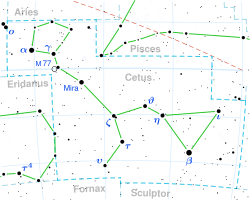Tau Ceti
| Observation data Epoch J2000 Equinox J2000 |
|
|---|---|
| Constellation | Cetus |
| Pronunciation | /ˌtaʊ ˈsiːtaɪ/ |
| Right ascension | 01h 44m 04.0829s |
| Declination | −15° 56′ 14.928″ |
| Apparent magnitude (V) | 3.50 ± 0.01 |
| Characteristics | |
| Spectral type | G8.5 V |
| U−B color index | +0.21 |
| B−V color index | +0.72 |
| Variable type | None |
| Astrometry | |
| Radial velocity (Rv) | −16.4 km/s |
| Proper motion (μ) |
RA: −1721.94 mas/yr Dec.: 854.17 mas/yr |
| Parallax (π) | 273.96 ± 0.17mas |
| Distance | 11.905 ± 0.007 ly (3.650 ± 0.002 pc) |
| Absolute magnitude (MV) | 5.69 ± 0.01 |
| Details | |
| Mass | 0.783 ± 0.012 M☉ |
| Radius | 0.793 ± 0.004 R☉ |
| Luminosity | 0.52 ± 0.03 L☉ |
| Luminosity (visual, LV) | 0.45 L☉ |
| Surface gravity (log g) | 4.4 cgs |
| Temperature | 5,344 ± 50 K |
| Metallicity | 28±3% Sun |
| Metallicity [Fe/H] | −0.55±0.05 dex |
| Rotation | 34 days |
| Age | 5.8 Gyr |
| Other designations | |
| Database references | |
| SIMBAD | data |
| ARICNS | data |
Tau Ceti (τ Cet, τ Ceti) is a star in the constellation Cetus that is spectrally similar to the Sun, although it has only about 78% of the Sun's mass. At a distance of just under 12 light-years (3.7 parsecs) from the Solar System, it is a relatively nearby star, and is the closest solitary G-class star. The star appears stable, with little stellar variation, and is metal-deficient.
Observations have detected more than ten times as much dust surrounding Tau Ceti as is present in the Solar System. Since December 2012, there has been evidence of possibly five planets orbiting Tau Ceti, with two of these being potentially in the habitable zone. Because of its debris disk, any planet orbiting Tau Ceti would face far more impact events than Earth. Despite this hurdle to habitability, its solar analog (Sun-like) characteristics have led to widespread interest in the star. Given its stability, similarity and relative proximity to the Sun, Tau Ceti is consistently listed as a target for the Search for Extra-Terrestrial Intelligence (SETI), and it appears in some science fiction literature.
It can be seen with the unaided eye as a third-magnitude star. As seen from Tau Ceti, the Sun would be a third-magnitude star in the northern hemisphere constellation Boötes.
...
Wikipedia

